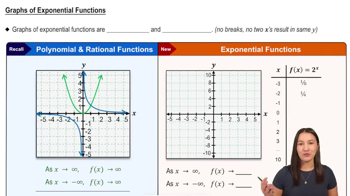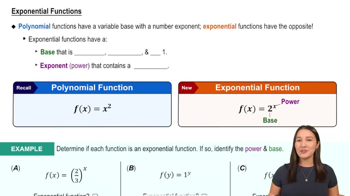Table of contents
- 0. Functions7h 52m
- Introduction to Functions16m
- Piecewise Functions10m
- Properties of Functions9m
- Common Functions1h 8m
- Transformations5m
- Combining Functions27m
- Exponent rules32m
- Exponential Functions28m
- Logarithmic Functions24m
- Properties of Logarithms34m
- Exponential & Logarithmic Equations35m
- Introduction to Trigonometric Functions38m
- Graphs of Trigonometric Functions44m
- Trigonometric Identities47m
- Inverse Trigonometric Functions48m
- 1. Limits and Continuity2h 2m
- 2. Intro to Derivatives1h 33m
- 3. Techniques of Differentiation3h 18m
- 4. Applications of Derivatives2h 38m
- 5. Graphical Applications of Derivatives6h 2m
- 6. Derivatives of Inverse, Exponential, & Logarithmic Functions2h 37m
- 7. Antiderivatives & Indefinite Integrals1h 26m
1. Limits and Continuity
Finding Limits Algebraically
Problem 95
Textbook Question
Find the horizontal asymptotes of each function using limits at infinity.
f(x) = (2ex + 3) / (ex + 1)
 Verified step by step guidance
Verified step by step guidance1
Identify the dominant terms in the numerator and the denominator as x approaches infinity. In this case, both the numerator and the denominator have the dominant term e^x.
Divide every term in the numerator and the denominator by the dominant term e^x to simplify the expression.
The expression becomes (2 + 3/e^x) / (1 + 1/e^x).
Evaluate the limit of the simplified expression as x approaches infinity. As x approaches infinity, the terms 3/e^x and 1/e^x approach 0.
The limit of the expression as x approaches infinity is 2/1, which suggests that the horizontal asymptote is y = 2.
Recommended similar problem, with video answer:
 Verified Solution
Verified SolutionThis video solution was recommended by our tutors as helpful for the problem above
Video duration:
3mPlay a video:
Was this helpful?
Key Concepts
Here are the essential concepts you must grasp in order to answer the question correctly.
Horizontal Asymptotes
Horizontal asymptotes describe the behavior of a function as the input approaches infinity or negative infinity. They indicate the value that the function approaches but does not necessarily reach. To find horizontal asymptotes, we analyze the limits of the function as x approaches infinity or negative infinity.
Recommended video:

Graphs of Exponential Functions
Limits at Infinity
Limits at infinity involve evaluating the behavior of a function as the variable approaches infinity or negative infinity. This concept is crucial for determining horizontal asymptotes, as it helps identify the value that the function stabilizes at for large magnitudes of x. Techniques such as dividing by the highest power of x in the denominator are often used in this analysis.
Recommended video:

One-Sided Limits
Exponential Functions
Exponential functions, such as e^x, grow rapidly as x increases. Understanding their growth rates is essential when analyzing limits at infinity, especially in rational functions where exponential terms can dominate. In the given function, recognizing how e^x behaves compared to constant terms is key to determining the horizontal asymptote.
Recommended video:

Exponential Functions

 5:21m
5:21mWatch next
Master Finding Limits by Direct Substitution with a bite sized video explanation from Callie
Start learningRelated Videos
Related Practice







